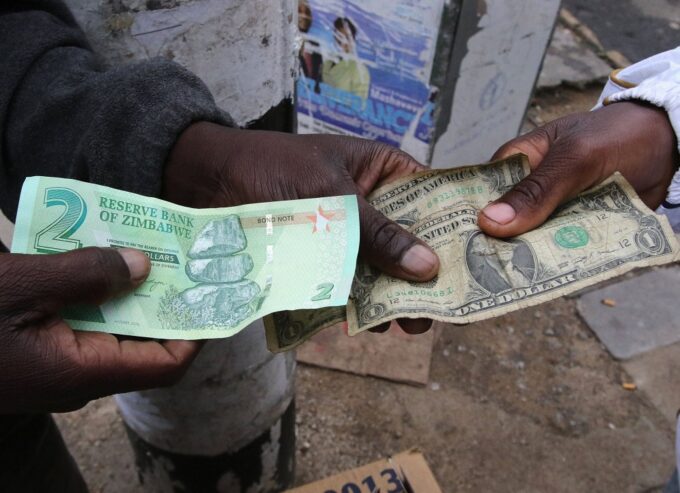
TAURAI MANGUDHLA THE Reserve Bank of Zimbabwe (RBZ) and Treasury have gone to town about stability obtaining on the local currency against the greenback but the economic problems facing Zimbabweans tell a different story.
While the official auction rate closed last week at below ZW$120 against the dollar, parallel market rates on the other hand have been skyrocketing, breaching the ZW$250-mark last week.
This was a function of demand on the auction system which continued to outweigh supply.
This is an apparent testimony to the failure of the forex auction system which has catered for 30% of the country’s formal foreign currency transactions, which is a small portion in the global mix.
The price of products on shelves is pointing to an adoption of parallel market rates since there is no justification for the increase in US dollar prices, based on the official auction rate, since 2019.
The Zimbabwean dollar suffered a crisis of confidence after the RBZ sneaked in bond notes which until 2019, on official introduction of the Zimbabwe dollar, traded at par with the US dollar.
From around ZW$190, before the Christmas holidays to above ZW$250, the local dollar has been on a slippery slope and making pricing for business a mammoth task.
While the RBZ has warned against foreign currency malpractices especially for businesses that benefit from the auction system, there have been huge delays in allocation of approved bids by as much as 13 weeks in the past with only part of the bids being approved, creating another funding deficit.
- Chamisa under fire over US$120K donation
- Mavhunga puts DeMbare into Chibuku quarterfinals
- Pension funds bet on Cabora Bassa oilfields
- Councils defy govt fire tender directive
Keep Reading
As a result, manufacturers, retailers and wholesalers have preferred the US dollar, chasing the parallel market rate to hedge against the exchange rate risk as well as building capacity to retool, restock and remain viable.
A snap survey by this publication on Wednesday this week shows that manufacturers are pegging their products at a rate of around ZWL$200 per US$1.
The country’s two major retailers OK Zimbabwe and TM/PicknPay are trading the US$ at 178.
Economist Chenaiyimoyo Mutambasere said businesses use the parallel market rates when pricing because of a serious foreign currency shortage on the auction.
She said companies have gone on to add a premium on parallel market rates because of the high level of volatility.
“It doesn’t make any sense for these locally manufactured products, even the imports to have gone up by more than 100% over the past two years.
“It just makes no sense at all and the obvious reason behind the price hikes in local currency is that companies are chasing parallel market rates, either to be able to stock or to encourage sales in US dollars,” Mutambasere said, adding that the exchange rate risk had become a huge problem.
“With the exchange risk in an environment like ours, a business charges a premium to hedge against shocks and that is exactly what has been happening.
The obvious solution is, and I have said this before, to dollarise,” she added.
Markets analyst Batanai Matsika said businesses are pricing using parallel market rates because that is where the bulk of their costs are.
“The auction remains insignificant in terms of the global foreign currency supply figure in Zimbabwe and you can see this by looking at the imports versus what the auction is availing.
“This means a majority of costs such as labour and transport among others are benchmarked against parallel market rates for the bulk of business,” Matsika said.
Chartered accountant Trust Chikohora further noted that pricing on the market is centred around the parallel market exchange rate due to a shortage of foreign currency on the auction floor.
“For some businesses, it is because they have no access to foreign currency on the auction, but it is not justified for those obtaining foreign currency on the auction.
“In this case it is not justified because they can replace stocks at those rates and this means they should be pricing using the auction rate.
This is the reason why I have always argued why it is important to follow up in ensuring that the auction benefit reflects in their pricing,” Chikohora said.
“It is important for the auction system to be efficient so that bona fide businesses who wish to get foreign currency can do that on time to avoid accessing funds from the parallel market,” Chikohora added.
Last week, RBZ governor John Mangudya in his Monetary Policy Statement (MPS), said the auction platform has since inception availed 30% of the country’s formal foreign currency transactions, leaving a huge gap and forcing businesses and individuals to resort to the parallel market where rates have since skyrocketed.
Mangudya said the parallel market exchange rate premium widened in the last quarter of 2021 to between 40% and 90% on account of the high demand for foreign currency driven by an increase in aggregate demand emanating from good agricultural outrun and general increase in economic activity and exports.
Hundreds of millions have so far been borrowed to back the auction, but results are far from ideal.
Mangudya said the ultimate solution to the country’s foreign currency situation is not borrowing but increased production, improved productivity and efficient mobilisation of domestic financial resources.
The foreign exchange auction system is now in its second year following its inception on June 23, 2020.











